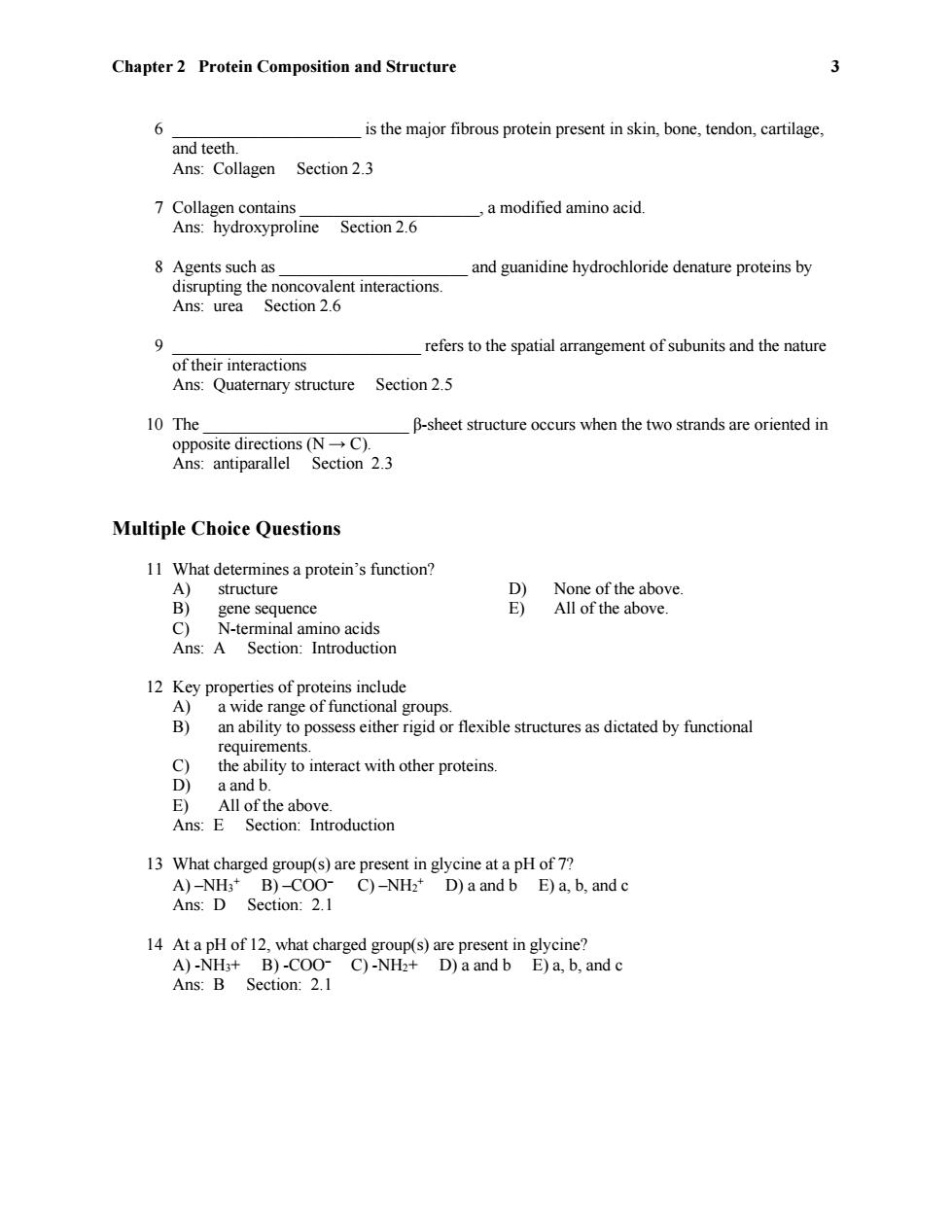正在加载图片...

Chapter 2 Protein Composition and Structure 3 6 is the major fibrous protein present in skin,bone,tendon,cartilage, and teeth. Ans:Collagen Section 2.3 7 Collagen contains a modified amino acid. Ans:hydroxyproline Section 2.6 8 Agents such as and guanidine hydrochloride denature proteins by disrupting the noncovalent interactions. Ans:urea Section 2.6 9 refers to the spatial arrangement of subunits and the nature of their interactions Ans:Quaternary structure Section 2.5 10 The B-sheet structure occurs when the two strands are oriented in opposite directions (N-C). Ans:antiparallel Section 2.3 Multiple Choice Questions 11 What determines a protein's function? A) structure D) None of the above. B) gene sequence E) All of the above. C) N-terminal amino acids Ans:A Section:Introduction 12 Key properties of proteins include A)a wide range of functional groups. B) an ability to possess either rigid or flexible structures as dictated by functional requirements. C) the ability to interact with other proteins. D) a and b. E)All of the above. Ans:E Section:Introduction 13 What charged group(s)are present in glycine at a pH of 7? A)-NH3+B)-COO-C)-NH2+D)a and b E)a,b,and c Ans:D Section:2.1 14 At a pH of 12,what charged group(s)are present in glycine? A)-NH3+B)-COO-C)-NH2+D)a and b E)a,b,and c Ans:B Section:2.1Chapter 2 Protein Composition and Structure 3 6 ______________________ is the major fibrous protein present in skin, bone, tendon, cartilage, and teeth. Ans: Collagen Section 2.3 7 Collagen contains _____________________, a modified amino acid. Ans: hydroxyproline Section 2.6 8 Agents such as ______________________ and guanidine hydrochloride denature proteins by disrupting the noncovalent interactions. Ans: urea Section 2.6 9 _____________________________ refers to the spatial arrangement of subunits and the nature of their interactions Ans: Quaternary structure Section 2.5 10 The ________________________ β-sheet structure occurs when the two strands are oriented in opposite directions (N → C). Ans: antiparallel Section 2.3 Multiple Choice Questions 11 What determines a protein’s function? A) structure D) None of the above. B) gene sequence E) All of the above. C) N-terminal amino acids Ans: A Section: Introduction 12 Key properties of proteins include A) a wide range of functional groups. B) an ability to possess either rigid or flexible structures as dictated by functional requirements. C) the ability to interact with other proteins. D) a and b. E) All of the above. Ans: E Section: Introduction 13 What charged group(s) are present in glycine at a pH of 7? A) –NH3+ B) –COO C) –NH2+ D) a and b E) a, b, and c Ans: D Section: 2.1 14 At a pH of 12, what charged group(s) are present in glycine? A) -NH3+ B) -COO C) -NH2+ D) a and b E) a, b, and c Ans: B Section: 2.1